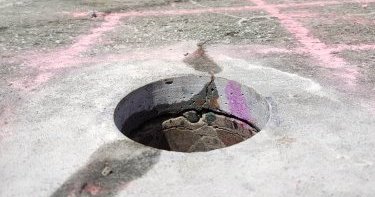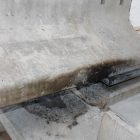The collapse of Ponte Morandi in Genoa, Italy (read more) and Florida International University pedestrian bridge (read more) have raised concerns about the safety and reliability of existing and new bridge structures. common Defects in bridge structures can affect the overall safety of the bridge structures. Different deterioration mechanisms can lead to major defects. Exiting infrastructure in developed countries are nearing the end of their initial service life design. According to the National Research Council Canada, one-third of Canada’s highway bridges have some structural or functional deficiencies and a short remaining service life. The condition of bridges in the United States in not different: According to the ASCE Infrastructure Report Card (2017) “The U.S. has 614,387 bridges, almost four in 10 of which are 50 years or older. 56,007 — 9.1% — of the nation’s bridges were structurally deficient in 2016”.

Designing Bridge Structures to Last
The Canadian Highway Bridge Design Code (S6-14, 2014) considers a service life of 75 years for newly constructed bridge. What does this mean in engineering terms? It means that the bridges of the future should have satisfactory performance, both durability and structural, during the proposed life-cycle. To achieve such service life, a carefully reviewed design and detailing is required. This should be followed by high quality construction work. Finally, a systematic maintenance plan (as part of asset management) should exist to ensure that the performance objectives are met at all times.

Common Defects in Bridge Structures
A- Defects in the Superstructure
Several deterioration mechanism can impact the integrity of bridge superstructure (mainly bridge decks). Depending on the material used in the construction of the bridge, different deterioration mechanisms can develop over time.
A1- CONCRETE BRIDGE STRUCTURES
SHRP Report S2-R06A has summarized some of the deterioration mechanism that contribute to most common defects in concrete bridge deck as:
* Corrosion (read more)
* Carbonation
*Alkali-Silica Reaction (read more)
* Influence of High Temperature
* Creep and Shrinkage
* Water penetration
* Freeze and Thaw
A2- STEEL BRIDGE STRUCTURES
Ontario Structure Inspection Manual (OSIM, 2008) summarizes some of the most common damage mechanisms in steel bridge structures as the following:
* Corrosion
* Fatigue (low cycle and high cycle)
* Cracks in elements and joints
* Deficiencies in connections
* Permanent Deformation (i.e. buckling, bending, etc.)

Defects in Substructure
Defects can also happen in the substructure components, such as the foundations, abutments and piers, and the retaining walls.
Substructure components can experience the same deterioration mechanism as described in the superstructure. Concrete piers, and abutments can experience deterioration as a results of steel rebar corrosion, freeze and thaw cycles, and alkali-silica reactions. These components can also experience deficiencies in their performance.
How to Detect Defects in Bridge Structures?
1- Routine Visual Inspection
Visual inspection of bridge components is the first action to identify the defects and quantify the extent and severity of the defects. Visual inspection of bridges is normally conducted on a routine basis. For example, in Ontario, Canada, bridges with spans of longer than 3 meters, must be visually inspected every two years (biennial inspection). The defects are marked and recorded. Based on the extent of the deterioration, the engineer can recommend additional testing (condition survey). OSIM (2008) provides a comprehensive approach to the close up visual inspection of bridge structures in Ontario (Remarks on Ontario Structure Inspection Manual)
2- Detailed Condition Survey
The condition survey of bridge structures often involve a series of destructive tests (sawing, cutting, taking core samples). Core samples are used to study the visual condition of the core profile (showing sign of cracks, corrosion, delamination), and testing them for compressive strength, and chloride content. The main advantage of these methods is their compliance with most codes and guidelines; however, one should note that the coring increases the chance of damaging an already damaged structure. Overall, destructive test methods are not particularly ideal for identifying the location and extent of defects in bridge structures over large areas (such as large bridge decks). To learn more about the challenges of these methods, read MAIN CHALLENGES OF CONCRETE CORING

3- Non-Destructive Testing
Several non-destructive testing (NDT/NDE) that can be used to evaluate the existing condition of different structural and non-structural components in bridge structures, and to identify the location and extent of defects in bridge structures. Most of these methods are widely used in the inspection of bridge decks; however, they can be used to evaluate the abutments, main reinforced concrete girders. The main advantage of NDT for bridge inspection is that it can be used to monitor a wider area in a relatively short time. The methods are repeatable, which means they are ideal for periodic routine inspection of bridges. Another big advantage of this group of tests is that they can be conducted with minimum intervention, and damage to the structure. To learn more about some of the most widely used NDT methods for bridge inspection, Read this:
NDT for Detailed Bridge Deck Condition Survey
Author: Hamed Layssi, PhD, PEng
Dr. Layssi is a passionate entrepreneur and professional engineer, and the co-founder of FPrimeC Solutions Inc. in Ottawa, Ontario. As chief structural evaluation engineer, Dr. Layssi brings his extensive experience in the condition assessment of infrastructure. Mr. Layssi holds a PhD from McGill University. He is a registered professional engineer in Ontario since 2014 and was awarded the 2018 entrepreneurship award by Professional Engineers Ontario – Ottawa chapter.








4 Methods of Condition Survey for Bridge Decks | FPrimeC Solutions
[…] Exposed Concrete Decks suffer from various deterioration mechanisms; i.e. freezing and thawing, corrosion. The most significant consequence is the delamination of concrete, which could eventually trigger other damage mechanism, such as corrosion. The maintenance of deck slabs is quite challenging mainly because it normally involves large areas; In many cases, closing the deck to traffic is extremely difficult, if not impossible. Existing (traditional) methods of condition survey for bridge decks involve chain dragging to identify and quantify delaminated areas; In this article, we will describe how non-destructive evaluation methods provide additional information about the condition of the deck slab. LEARN MORE: COMMON DEFECTS IN BRIDGE STRUCTURES […]
How to Evaluate Bridge Abutments? | FPrimeC Solutions
[…] ← Common Defects in Bridge Structures4 NDT Methods for Concrete Imaging and Scanning → […]
Construction damage survey
Survey if done on time can really prevent hazardous incidents. It can be seen that a lot of people dies due to bad materials used in construction of roads, dams, bridges etc. So, survey should be done from time to time to figure out the exact position of the dams. Thanks.
Construction damage survey
Danny F
Good to know, will certainly pass on the news! Glad I saw this, will be following for more
Non-Destructive Testing for Structural Condition Assessment | FPrimeC Solutions
[…] existing condition of the structure, investigation. In doing so, engineers are looking for signs of defects and distress in structural elements in the first step. Close up visual inspection of elements provides a cost-effective method for […]
Structural Health Monitoring for Bridge Structures | FPrimeC Solutions
[…] loading conditions, such as snow, rain, storm, and extreme heat. This could cause expedite deterioration process in the construction materials, such as concrete and steel. Moreover, physical loads (caused […]
Mohammad Mukhlis Behsoodi
Thank you very much
Alice Carroll
Thanks for explaining that freezing and thawing can cause defects on bridges fairly easily. I'd like I'd know more about the construction of timber bridges because there is a small stream running through my rural property that I'd like to be able to cross easily. Having a narrow bridge there will be a huge help.